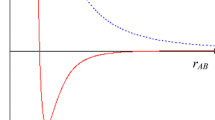Abstract
The drastically increasing availability ofmodern computers coupled with the equally drasticallylower cost of a given amount of computer power inrecent years has resulted in the evolution of thetraditional experimental/theoretical dichotomy inchemistry into anexperimental/theoretical/computational trichotomy. This trichotomy can be schematically represented by atriangle (the ETC triangle) with experimental,theoretical, and computational chemistry at the threevertices. The ET and EC edges of the ETC triangledepict the uses of theoretical and computationalchemistry, respectively, to predict and interpretexperimental results. The TC edge depicts therelationship between theoretical and computationalchemistry. Mathematics plays an increasing role in allaspects of chemistry, particularly theoreticalchemistry, and has led to the evolution of thediscipline of mathematical chemistry. Research inmathematical chemistry can be considered to lie on achemistry-mathematics continuum depending on therelative depths of the underlying chemistry andmathematics. Examples of the author's own researchlying near each end of the chemistry-mathematicscontinuum include his work on applications of graphtheory and topology in inorganic coordination andcluster chemistry lying near the chemistry end and hiswork on chirality algebra lying near the mathematicsend. The general points in this essay are illustratedby an analysis of the roles of computational andtheoretical chemistry in developing an understandingof structure and bonding in deltahedral boranes andrelated carboranes. This work has allowed extensionof the concept of aromaticity from two dimensions asin benzene and other planar hydrocarbons to the thirddimension in deltahedral boranes.
Similar content being viewed by others
REFERENCES
J. Aihara. Three-Dimensional Aromaticity of Polyhedral Boranes. Journal of American Chemical Society 100: 3339, 1977.
D.R. Armstrong, P.G. Perkins, and J.J.P. Stewart. Calculation of the Electronic Structure of Boranes by the Self-consistent Molecular Orbital Method. Part II. Highly Symmetrical Cage Anions. Journal of the Chemical Society Dalton Transactions: 627, 1973.
M. Bruckner. Vielecke und Vielfläche. Teubner, Leipzig, 1900.
W.E. Byerly. An Elementary Treatise on Fourier's Series and Spherical, Cylindrical, and Ellipsoidal Harmonics. Dover, New York, NY, 1959 (reprinted from an 1893 Edition published by Ginn and Company).
B. Grünbaum. Convex Polytopes, pp. 253–271. Interscience, New York, NY, 1967.
M.F. Hawthorne. Biochemical Applications of Boron Cluster Chemistry. Pure and Applied Chemistry 63: 327, 1991.
M.F. Hawthorne. The Role of Chemistry in the Development of Boron Neutron Capture Therapy for Cancer. Angewandte Chemie International Edition in Englisch 32: 950, 1993.
R. Hoffmann and W. Lipscomb. Theory of Polyhedral Molecules. I. Physical Factorizations of the Secular Equation. Journal of Chemical Physics 36: 2179, 1962
R.B. King (Ed.). Chemical Applications of Topology and Graph Theory. Elsevier Science Publishers, Amsterdam, Netherlands, 1983. xii + 494 pp.
R.B. King. Chirality Algebra. In: P. Mezey (Ed.), New Developments in Molecular Chirality, pp. 131–164. Kluwer Academic Publishers, Dordrecht, 1991.
R.B. King. Applications of Graph Theory and Topology in Inorganic Cluster and Coordination Chemistry. CRC Press, Boca Raton, FL, 1993. 229 pp.
R.B. King. Chemical Applications of Topology and Group Theory. 29. Low Density Polymeric Carbon Allotropes Based on Negative Curvature Structures. Journal of Physical Chemistry 100: 15096, 1996.
R.B. King and A.J.W. Duijvestijn. The Topological Uniqueness of the Deltahedra Found in the Boranes BnH 2- n (6 ≤ n ≤ 12). Inorganic Chimica Acta 178: 55, 1990.
R.B. King and D.H. Rouvray. Chemical Applications of Group Theory and Topology. VII. A Graph-Theoretical Interpretation of the Bonding Topology in Polyhedral Boranes, Carboranes, and Metal Clusters. Journal of the American Chemical Society 99: 7834, 1977.
R.B. King and D.H. Rouvray (Eds.). Graph Theory and Topology in Chemistry. Elsevier Science Publishers, Amsterdam, Netherlands, 1987. xv + 575 pp.
R.B. King, B. Dai and B. Gimarc. Three-Dimensional Aromaticity in Deltahedral Borane Anions: Comparison of Topological and Computational Approaches. Inorganic Chimica Acta 167: 213, 1990.
F. Klein. Ñber die Transformation siebenter Ordnung der elliptischen Funktionen. Math. Ann. 14: 428, 1879; F. Klein, Gesammelte Mathematischen Abhandlungen, Vol. 3, pp. 90-136. Springer Verlag, Berlin, 1923.
W. Moore. Schrödinger: Life and Thought, Chapter 6. Cambridge University Press, Cambridge, 1989.
E.L. Muetterties and W.H. Knoth. Polyhedral Boranes. Marcel Dekker, NewYork, NY, 1968.
J.J. Ott and B.M. Gimarc. Optimized Structures and Relative Stabilities of the Carboranes from Ab Initio Calculations. Journal of Computational Chemistry 7: 673, 1986.
A.S. Perelson (Ed.). Theoretical Immunology, Part One. Redwood City, California: Santa Fe Institute Studies in the Science of Complexity, Addison-Wesley Publishing Company, 1988.
W.W. Porterfield, M.E. Jones, W.R. Gill and K. Wade. Extended Hückel MO Studies of Boranes 1. Relative Stabilities of closo-BnHn and-BnH /2 n - Inorganic Chemistry 29: 2914, 1980.
P.v.R. Schleyer and K. Najafian. Stability and Three-Dimensional Aromaticity of closo-Monocarborane Anions, CB n-1H - n , and closo-Dicarboranes C2Bn-2Hn. Inorganic Chemistry 37: 3454, 1998.
L.G. Sneddon, M.G. Mirabelli, A.T. Lynch, P.J. Fazen, K. Su and J.S. Beck. Polymeric Precursors to Boron Based Ceramics. Pure and Applied Chemistry 63: 407, 1991.
A.J. Stone and M.J. Alderton. A New Model of Structure and Bonding in the Boron Hydrides. Inorganic Chemistry 21: 2297, 1982.
Author information
Authors and Affiliations
Rights and permissions
About this article
Cite this article
King, R.B. The Role of Mathematics in the Experimental/Theoretical/Computational Trichotomy of Chemistry. Foundations of Chemistry 2, 221–236 (2000). https://doi.org/10.1023/A:1009989423317
Issue Date:
DOI: https://doi.org/10.1023/A:1009989423317




